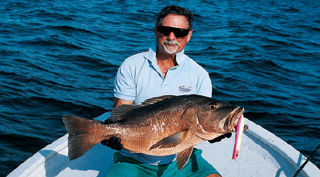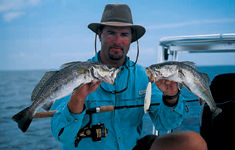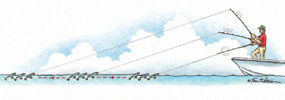|
|
The secret to catching more and bigger fish on topwater plugs is really pretty simple: you’ve got to make the lure look alive. This often requires fine-tuning the action of the plug to coax non-feeding fish into striking. Hit the right combination and you’ll be rewarded with some awesome strikes.
Almost any topwater plug will catch game fish when they’re feeding aggressively at the surface. However, keeping those strikes coming when the feeding subsides is another matter. By combining the following guidelines with a little personalized tweaking of the retrieve, you’ll get the most from your plugs and bag some quality fish in the process.
Choose Your Weapon
|
|
Lure size influences what you may or may not catch on any given day. One foolproof tip is to choose a plug that’s similar in size and shape to the local forage, particularly when there’s an abundance of a specific bait. I’ve seen this ’match the hatch’ theory unfold numerous times, such as when fishing for snook and redfish around schools of finger mullet, speckled trout that were foraging on pilchards, and striped bass in hot pursuit of peanut bunker.
Matching lure size to the local forage works well on schooling game fish. However, if you desire quality over quantity, and don’t mind the wait between strikes, step up the size of your plug. For instance, if you’ve been catching average-sized fish on a three-inch plug and want to tempt a lunker, upgrade to a five-inch plug. Doing so will keep the lure in play much longer, simply because the smaller, more aggressive fish may be intimidated by a big bait and shy away from attacking it. What’s more, the size, sound and action of the larger plug should draw more attention, regardless of whether the bait is thick or sparse, and could prove too tempting for a larger predator to ignore.
A recent example of this occurred while I was testing out a new surface lure in Florida’s Biscayne Bay. Since most of the speckled trout around Miami weigh less than two pounds, I tied on the five-inch, walk-the-dog-style plug with the anticipation of possibly hooking a snook, tarpon or big jack. To my surprise, my initial five casts produced a pair of 3 1/2-pound trout and a four-pounder! I used the same lures on a speckled trout trip in Alabama a few weeks later and caught several fat specks from four to seven pounds.
Color Me Caught
|
|
Similar to the match-the-hatch theory, I firmly believe in duplicating the natural color of the local forage, especially if it’s abundant. I’ve discovered that by matching these colors, such as using a gold/bronze plug to mirror menhaden or black/silver for mullet, I often out-fish friends who are using markedly different colors.
Of course, there are exceptions. Even though game fish use their lateral line to home in on lure vibrations, they’ll occasionally miss plugs they can’t see on the strike. Therefore, when water clarity is marginal, it may prove more effective to choose a brighter color or a pattern that provides a stronger contrast than the local bait. An example would be to use a pure-white, bone or chrome-finished lure in tannin-stained or muddy water, which could provide that extra bit of visibility a game fish needs when it closes in for the kill. It’s pretty much the same principle when using white, bone and other light colors on overcast or moonless nights, and black or dark shades on moonlit evenings, all of which provides more contrast to enhance the plug’s visibility.
The style of topwater plug determines the sounds and vibrations it will emit. For example, round, cigar-shaped lures coveted for their side-to-side ’walk-the-dog’ action emit a softer sound, compared to the loud popping sound made by topwater plugs with cupped or slanted heads. As a very general rule, the latter styles rely more on their sound to attract fish, whereas the ones with rounded heads require more action and finesse to produce.
A chugger-style plug is a good bet for fast, aggressive fish, such as jack crevalle, bluefish, Spanish mackerel and even striped bass when they’re feeding on the run. The loud chugging sound can be detected by fish over a greater distance and helps draw attention to the plug. Chuggers and poppers are also great for teasing fish into striking.
By comparison, a walk-the-dog-type surface plug generally excels when game fish are lurking near cover or beneath bait. In this situation, producing a strike requires a very convincing action.
Keep It Moving
|
|
The precise action of your lure should be governed by the game fish you’re pursuing, and perhaps even by how the local baitfish are acting. For example, jacks, bluefish, barracuda, Spanish mackerel and other fast, aggressive fish usually respond to rapid, steady retrieves highlighted by a lot of lure action. Should one of these fish follow the lure for a closer look, immediately increase the speed and action of the plug. Make it appear as if it’s struggling to get away and a strike is virtually assured. Never slow or stop the retrieve with a fish in pursuit, even as the lure nears the boat. Doing so may give the fish time to realize the plug’s a fake and lose interest. Instead, quickly retrieve the plug to the boat, pull it from the water and make another cast.
With structure-oriented fish such as snook, stripers, trout and redfish, opt for a slower retrieve and a much tighter action. When fishing topwater lures for these fish, I’ll begin by slowly and continuously reeling in line and twitching the lure every other second (counting time like so: ’one-thousand-one, short twitch, one-thousand-two, short twitch, etc.’). This short twitch, made with a quick, firm stroke of the rod tip, causes the lure to dart to the side or forward, depending on its design. This ’mild’ action, coupled with a steady retrieve, makes the lure much easier for fish to home in on and hit.
When more action is necessary, I’ll maintain the same retrieve speed and increase the frequency and sharpness of the twitches. By imparting two and sometimes three sharp twitches per second, I’ll tighten the action and make the lure appear more panicked. This is quite effective after a feeding blitz has subsided, where the plug resembles an injured baitfish that has been separated from the school and is desperately trying to escape.
If that doesn’t produce a strike I’ll try increasing the retrieve speed and imparting longer rod strokes to broaden the lure’s side-to-side action or forward surges. Sometimes I’ll improvise by dipping the rod tip to the water, causing the lure to dart erratically just under the surface, then following it up with a series of side-to-side surface twitches. Experimen-tation is the key. Vary the speed and action of the lure until you find one that excites the fish.
Fancy Rod Work
|
|
Despite the fact that most strikes occur close to structure, such as mangroves, bridges or docks, I still favor playing a lure all the way back to the boat. Cut a retrieve short and you might miss an opportunity to catch a game fish that may have been following the plug for some distance.
A consistent lure action is also important to me. I tend to begin my retrieve by holding the rod tip high (in open water or when working the lure along a shadow line, shoreline or pilings) or almost parallel to the water (if working a plug from underneath mangroves and overhanging structure). The relatively sharp angle of the line keeps the lure’s head tilted slightly upward during the initial retrieve, creating a lot of commotion. When the retrieve is half complete, I generally lower the rod tip ten to 15 degrees or so to maintain the same line angle and pull on the lure. As the lure nears the boat, I’ll lower the rod tip even more, sometimes just above the water, to keep the lure action consistent to the very end. Again, experiment with rod angles in an effort to maximize your lure’s surface action.
Considering the sharpness of hooks these days, it’s amazing how many fish fail to hook themselves on the strike. The best advice for setting the hook on a topwater plug is to keep reeling during the strike until you feel solid resistance. Do not rear back on the rod, which could send the plug skyrocketing from the water if the fish misses it, thereby taking it out of play. Reel until the fish begins taking line, then set the hook with a quick stroke or two, holding the rod parallel to the water.
Should the fish miss the lure, don’t slow or stop the retrieve. Keep it moving right along, perhaps twitching it a few more times to increase the appearance of panic. Many times the same fish, or a companion, will come right back and clobber it, giving you another opportunity to score.






